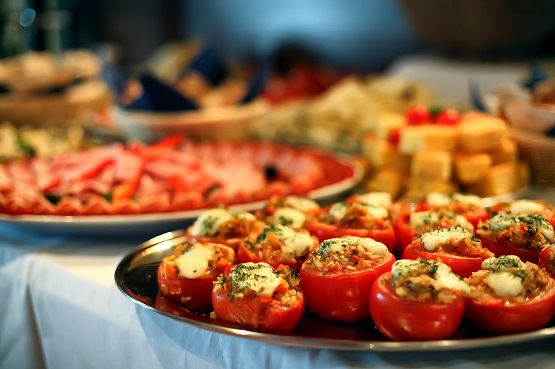Did you know that people in the United States alone eat almost a ton of food every year? Of course, you won't have to serve a literal ton of food at your next party, but you will still have to figure out how to plan your party catering so there will be more than enough food for everyone. The problem is that this is easier said than done.
How can you calculate how much food your guests might eat? How should you calculate the appetizers compared to the main course? And, of course, what about dessert as well as the individual appetites of your guests?
As it turns out, figuring out how much food you need to serve for your next party isn't as hard as you might think. There are a few tips and tricks you can follow that will ensure your guests will never be left hungry. Keep reading and learn more about what you need to know when it comes to measuring out food for guests.
Consider the Type of Party You’re Having
Before you plan a party, you should know that no party is the same. For that reason, different types of parties may have more or less food available than others. For example, there is a big difference between a cocktail party and a dinner party. A cocktail party focuses, unsurprisingly, on cocktails, but appetizers and snacks are often available.
A cocktail party usually has a big dinner at the heart of it, but some cocktail parties are more casual and they may skip the dinner in favor of more small snacks. This kind of party focuses more on the combination of different types of alcohol, bitters, ice, and other ingredients. It is a more relaxed party and your guests might even have the chance to mix their own favorite cocktails if they want.
Types of Parties
A dinner party, on the other hand, is less about drinking and more about eating. For this kind of party, you will need to think about every type of meal that will come across the table from the appetizers, the main dish, the side dishes, and the dessert. There are, of course, other types of parties that may change things up and may only serve certain types of food or certain portions at certain times.
Once you figure out what kind of party you're going to have, planning out the meals and the amount of food you'll need will be much easier. Whether you're catering for a party or making all the food on your own, you will need to think about your guests, what they like and don't like, the things they might not be able to eat, and how much they're able to eat without feeling overly stuffed or still hungry.
Keep in mind that overfeeding your guests is just as bad as underfeeding them. If you underfeed your guests, they'll complain that they're still hungry. On the other hand, if you overfeed them, there will be a bunch of food leftover that you paid good money for.
So, how can you make sure that you pick the perfect food portions?
Consider the Number of Food Choices Available
Party planning on its own can be a stressful endeavor and bringing food portions into it can make it even more stressful. But fortunately, there is an easy way you can figure out how much food to serve. The way to do this is to think about what kind of food you plan on serving at your party.
For example, do you plan on offering ten different main meal options throughout the party? Or do you plan on limiting the meal options to three or four? The number of options you offer at your party is important because it will determine how much time it will take to prepare everything and the number of ingredients that are necessary.
The Details
In particular, if you offer more food options at your party, you will want to make each of those food options relatively small. Why might this be, you ask? Imagine trying to handle ten different food options with all different ingredients, preparation times, and more.
This can be very hard to deal with and very demanding. It can actually be nearly impossible to do this with so many different meal options. On the other hand, if you make all those meal options much smaller, the task will be much easier to deal with.
In the same vein, if you are only serving a few different types of food, you'll be able to make the meals larger than average to keep everyone satisfied. You'll have a large quantity of the same ingredients available and you'll be able to produce large meals without much of an issue because there are so few options. If you follow this tip, you'll find that serving the right amount of food will be easier than ever.
Consider the Different Portions
Once you know what kind of food you plan on serving at your party, you will need to think about the specific portions you plan to serve. First, consider the hors d'oeuvres. They should be small but plentiful.
For example, some common hors d'oeuvres include deviled eggs, cocktail shrimp, chips and dip, and so on. You'll want to make sure that your guests don't get too filled up on hors d'oeuvres before the main meal starts. You also don't want to deprive them of food, otherwise, they'll be famished.
Most people tend to take only a few bites (around six) of hors d'oeuvres before dinner. If you calculate this in accordance with the number of guests coming to your party, it shouldn't be too hard to gather together enough hors d'oeuvres for everyone. If you are still unsure about your estimates, always round up so there's a little extra.
The Main Meal
For the main meal, meat is usually the star. Try to provide six ounces of meat, whether it be beef, pork, or poultry, for every guest. Any more than six ounces of meat might bore your guests' taste buds.
For rice or pasta, two ounces is ideal. Both rice and pasta can be quite heavy so a portion of more than two ounces might make your guests feel overfull. Vegetables, on the other hand, are quite light, so you should serve around four ounces of them with your main meal per person.
If you plan on serving soup or salad with dinner or beforehand, make sure that they are only around one ounce. This will ensure that your guests stay hungry enough for the main course. As for dessert, try to serve one slice of pie or cake per person.
If you are serving pudding or mousse, you can serve around five ounces per person.
A Few More Meal Planning Tips to Consider
When it comes to planning a party, the last thing you want to do is bore your guests with too much of the same food. For example, if you served chips and salsa as an appetizer, you won't want to have any salsa with your main meal. Repeating the same ingredients can quickly get old.
You will also want to think about the colors of the food you plan on serving. If the main meal is full of brown, white, or otherwise neutral colors, it might not look very attractive and it certainly won't be a sensational meal. To change this up, all you need to do is ensure that there is plenty of variety.
You can do this by incorporating different vegetables, side dishes, and more for your main dish. If your food is full of bright and varied colors, the food will look much more appealing and, as a result, your guests will be very glad to start eating. Finally, the texture of your food is important.
The last thing you want to do is serve food with all the same texture. For example, if all of your food is very soft, it won't tantalize anyone's palate. On the other hand, if all your food is crunchy, it can be exhausting for your guests' jaws and teeth.
To fix this problem, make sure you vary soft foods with harder foods.
All about Party Catering
Party catering doesn't have to be difficult as long as you know what to do and where to start. You don't want to overfeed or underfeed your guests. To accomplish this, think about portion sizes for different types of food.
Also, consider what kind of party you plan to have and what kind of food you plan to serve. To learn more about planning events, check out our blog.

